|
Crime Noir is its own genre in the world of diabolical trade. It is defined by its popular film incarnation Film Noir— sophisticated killers matched against the hard boiled detective. Detectives love the image. As for the criminals?— well, in real life few are as sophisticated as their film counterparts. But there have been a few. Some have been caught. Others have not. Yet they have left enough clues to give us an idea of how careful and calculated they were.
Black and White is really a good world for these villains. Despite their belief in their own cleverness, they are bloodless, little people festering in dark shadows, doing their abominable deeds in dank basements. They waylay in dirty alleys. They prey upon the desperate and unsuspecting. The result is a grandstand of gore.
Such is the mysterious and macabre case of The Black Dahlia. The murder of “Black Dahlia” captured the senses of the nation and especially Los Angeles in 1947. The Press gave the victim perhaps a slightly more exotic background than she really had. Nevertheless, she was an enigmatic Hollywood glamour wannabe. She was promoted as someone who knew Los Angeles and who knew who were the rats and who weren’t. This made all the locals curious as to just how she could disappear for near a week and then end up mutilated and cut in half in an empty lot in a respectable though very proletarian residential neighborhood in the Leimert Park area of Los Angeles.
But let’s get to a few details here first. Her name: Elizabeth Short. Trade— there’s never been a nice word for it, but there are some euphemistic ones. Call Girl. Desperate. Struggling. Disillusioned.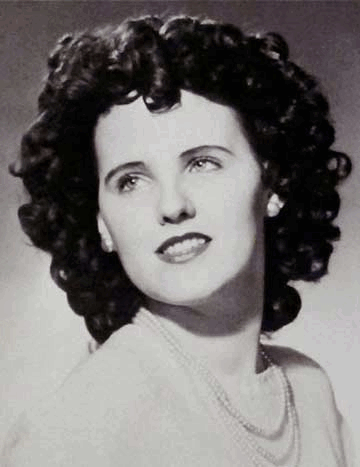 Hollywood has a lot of long, hard stories and big sad eyes. The combination appeals to some. Others just take advantage of it. Hollywood has a lot of long, hard stories and big sad eyes. The combination appeals to some. Others just take advantage of it.
Hollywood is full of “enigmatic” people covering their past deeds . . . or just failing to mention there was nothing particularly interesting in their life to date. Enigma sometimes results from avoiding your past rather than there really being anything truly mysterious in your background.
It is this element in the past of Liz Short’s very short life that made her an enigma. The circumstances of her death are those that would be reserved for someone, well, let’s say, special, at least in the cruel sport of revenge. This added to her enigma. Just who was this obscure wannabe really?
In truth, Liz Short was actually new to the Hollywood scene. She had arrived only back in June 1946. She was “fancy poor,” as the saying goes. You couldn’t tell she was only 22, for she was hardly the image of her age and class. She dressed immaculately, supposedly from the money she saved while being a not-so-glamorous waitress. She favored sleek black suits and long black gloves. She posed for glamour photos, sometimes with a flower in her hair. She was quite lovely and appeared much older. She had stunning green eyes, raven black hair, bright read lips, and skin of alabaster. One writer has likened her to a porcelain doll.
Liz Short was also a flaker. Gals like Liz roomed in two-bit boarding houses or houses with a number of girls paying their share to make rent. She welshed often and was often out of work. By the end of her Hollywood sojourn, her roommates noticed that she was out with a boyfriend every night and didn’t have a job.
Only 6 months after she had arrived, Liz Short was already thinking of moving to Chicago to be a fashion model. Perhaps she realized that she wasn’t ready for Hollywood yet. Chicago grooming might help pave the way for a mightier return. Perhaps she was simply failing.
. . . Perhaps someone wasn’t happy about her leaving at all.
On January 9, 1947, an acquaintance, Robert “Red” Manley, drove her to the Biltmore Hotel in Los Angeles. She had said she was going to meet her sister there. Quite a posh place. Neither Liz nor any relative could have afforded it. Manley testified that he left her there, last seeing her around 6:30 p.m.
She was dressed well to meet someone special, for so it would seem. She had on a black dress, most likely cardigan style, and she wore long white gloves. Her high heel shoes were black suede. It was a chipper evening and she wore a beige coat. Her purse, naturally, was black.
Liz Short was next seen, about a week later on January 15. She was found nude, cut in half and palced in the weeds by the sidewalk on South Norton Street in the less than fashionable Leimert Park area of Los Angeles. The street was under construction, home building having begun in 1941. The whole block was not yet finished. There were still open lots overgrown with weeds. Other than the sidewalk the only cement poured was for the entrance to driveways, and these only as far as the overgrown sidewalk. It was by one of these that her body had been placed. Her upper body and lower body were about a foot apart. Her upper body was “posed” with her arms over her head, as though this was a glamour shot. Her lower body was “posed” as well, though not so complimentary. Her legs were almost straight out and spread.
The symbolism seemed to speak much— the appearance of glamour (on top) but her real talent (or profession) reflected ignominiously in the lower half.
Liz Short was mutilated. The villain had carved the Glasgow Smile into her face. This is the act of cutting the cheeks from the corner of the mouth to the ears in order to imitate the warped smile of a grinning clown. Postmortem proved she had been alive when it was done. Her wrists and ankles had marks indicating she had once been bound and struggled against the inhuman torture. Other desecrations were done to her while alive. But she was apparently killed by bludgeoning to the head. Then she was cut in half, drained of blood and washed— probably for travel purposes. After the villain dumped her in the lot, posing her for all to see, he quietly escaped. He kept none of her. Her intestines had obviously been severed, but he tucked those under her buttocks before he left.
When the body was found there was a sensation. Since she had liked black dresses and was a bit exotic and enigmatic, she was dubbed “Black Dahlia.” Black Dahlia is an exotic flower, and at this time the movie The Blue Dahlia was quite popular and spoke of the exotic. There is some debate whether the Press made this up or her various girlfriends. She didn’t have any close friends. She jumped from one place to another and possibly had earned nothing but a nickname.
This became the mysterious and macabre case of The Black Dahlia.
There isn’t much on it, as I said, that is truly reliable. Liz Short was an out-of-towner in a big and potentially dangerous city, and her lifestyle only catered to those who might want to take advantage of it. As every LA detective knows, and has probably said at least once: “There’s a lot of ways to be murdered in the city if you are looking for it.” Liz wasn’t looking for it intentionally, but she was certainly courting it carelessly.
Obviously, the murder was neatly planned. Short had vanished at the Biltmore (supposedly). She had been taken somewhere quiet so she could be held for days and tortured. Then she was butchered and the area cleaned. The murder scene was never found. Clearly, this wasn’t some heated act or impulsive act of revenge. Someone subjected “Black Dahlia” to unusual torture and punishment— very calculated acts— and then, paradoxically, aggressively bludgeoned beat her to death. The killer had more of a point to make than satisfying his sadism. She could have been disposed of without drawing any attention, but the killer then transported her by night, January 15, 1947, and placed her in a middle class neighborhood. By posing her, he let them all know she deserved her fate. . . at least as he saw it.
Naturally the police noticed this. This was special revenge or someone who delighted in torture and sadistic pleasure and who found a gullible partner for the night.
The scenario has all the attributes of a serial killer. But there were no more murders like this. Black Dahlia, the exotic, enigmatic, party girl model-wannabe was it.
There were many suspects, of course. But one really doesn’t appear favored over the other. The clues in her murder were contradictory. There was revenge, but there were also clues that indicated a haughty person used her for a guinea pig of torture.
Did her killer really know her? She went to the Biltmore for a reason, though not the one given. She was down and out, as always. Who did she encounter there or after she left?
Whoever it was, someone saw fit to contact the Los Angeles Examiner on January 23. He said he was the murderer. He offered to send in some of her things. This is the usual route of cranks and erratic minds. But this time it was for real. A parcel arrived containing Liz Short’s birth certificate, business cards, photographs, various names written on pieces of paper, and, as an added touch of revenge, there was an address book. The name on it was Mark Hansen.
Police immediately questioned him. He turned out to have been an acquaintance of Liz Short’s.
The caller to the Examiner had expressed his concern that the publicity was dying out. For this reason he would send in her things. He certainly was good to his word. The Press ran with it and several letters later came in written by someone using the moniker The Black Dahlia Avenger”— whatever that might mean. But the caller was good to his intents. He wanted more publicity, and it doesn’t seem this was a Press stunt. On January 25, 2 days later, one of Liz Short’s black shoes and purse were seen on the lid of a garbage can in a nearby alley to where she had been found. By the time the police had arrived the garbage had been picked up. They were found at the dump.
Curious epilogue. The killer risked the danger of returning to the general area and placing evidence on a garbage can. Apparently it was pick-up day. Did he intend the evidence to be seen?
These questions need not be answered here. This article’s ultimate purpose is to start from the beginning. In fact, there isn’t much information out there at all. Most is folklore or unreliable thirdhand information. We must restart the investigation from scratch.
Unfortunately, even the location of where the body had been dumped was lost. I had to find it again. It is commonly said (on the web) that the body was dumped down South Norton between Coliseum and 39th Street in the 3800 block of Norton. This is not correct.
The apocryphal spot is not only wrong, it sets up false clues. The false area is far south on Norton from Coliseum, and the area wasn’t even under construction back then. If it was the accurate location, it would mean the killer took the chance to drive down a lonely road quite a distance. This is chancy. There would be no quick escape if a police car or someone by else drove by. A car stopped by open lots here would look suspicious.
The correct spot is right north of Coliseum on South Norton, in the 3700 block between Coliseum and Rodeo. Police photographs of the body, with the houses that were already built in the background, provides us with the exact location today. The same driveway and sidewalk are still present.
Contemporary crime scene photos show that the closest homes were built halfway down the street. The rest of the street were bare lots overgrown with weeds. Only the sidewalks and the entrance to the driveways were laid out, and they too were overgrown with the grass and weeds from the open lots. Thus the villain, whoever he was, took her body to a new section of town, but dumped it in the one area of the block where no one would see him. The photos show that the closest home to the body is about 5 empty lots down the block.
As interest in the Black Dahlia case resumed in the 1980s, the murder became famous for another generation— the quintessential unsolved Hollywood murder from the classic days of Film Noir. When this interest poured over into the World Wide Web, amateur sleuths tried to find the location on S. Norton. The street, of course, now looked much different. It was completely built up with homes, the last group being built in the 1956 period. It had thus been a long-established neighborhood with well kept lawns. The only thing remaining from old crime scene photos were the sidewalks and the driveway entryways, and some of these have been replaced with new cement.
Nevertheless, crime scene photos showed the back of houses along the parallel street (Grayburn Avenue), and that the distant houses on S. Norton. These homes remain today. Fortunately, so do the lamp posts. Street lights are not moved. They may be updated for modern tastes, but they remain where they were placed. With these we can find the exact location.
However, the actual location is nowhere near where enthusiasts have put it. A home at 3825 S. Norton has become accepted as the location, with the driveway of the neighbor’s being the one in the crime scene photo by which Black Dahlia was dumped. Although I don’t like to mention addresses, it has been plastered all over the Web, so there is little reason in foregoing. That entire block was not even begun until 1956.
Let’s start all over again.
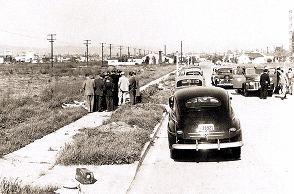 
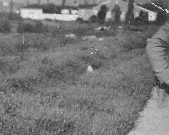
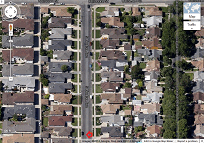 
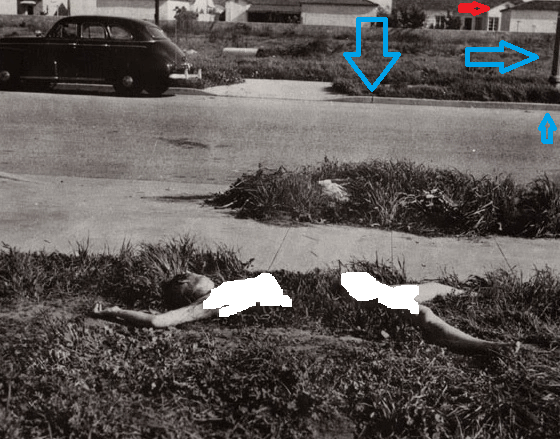
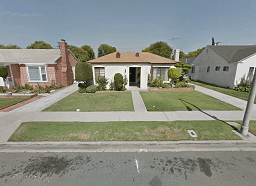 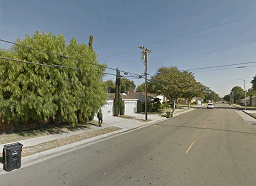
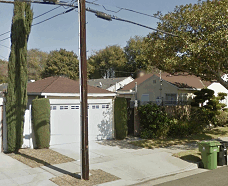
 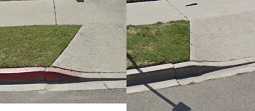
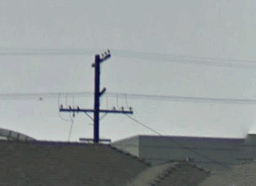
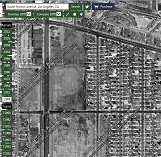 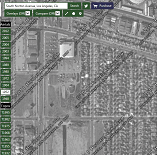 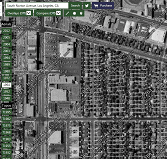
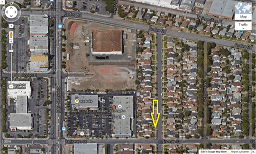

Having established the exact location in the 3700 block, we can assume that the killer came down Coliseum. He dumps the body and pulls out back to Coliseum. He would not have come down Rodeo, as that would mean driving in front of homes already built. He would want to awake no one or alert anyone awake that a car is passing by. But where had he come from before this? Crenshaw? Exposition? He could have come from West Exposition or King Jr Blvd, but not from the east, not from the residences. How far did he drive, and where did he go?
In an introduction the question does not have to be answered. But it is a logistic one that he had to carefully consider for his own protection.
|